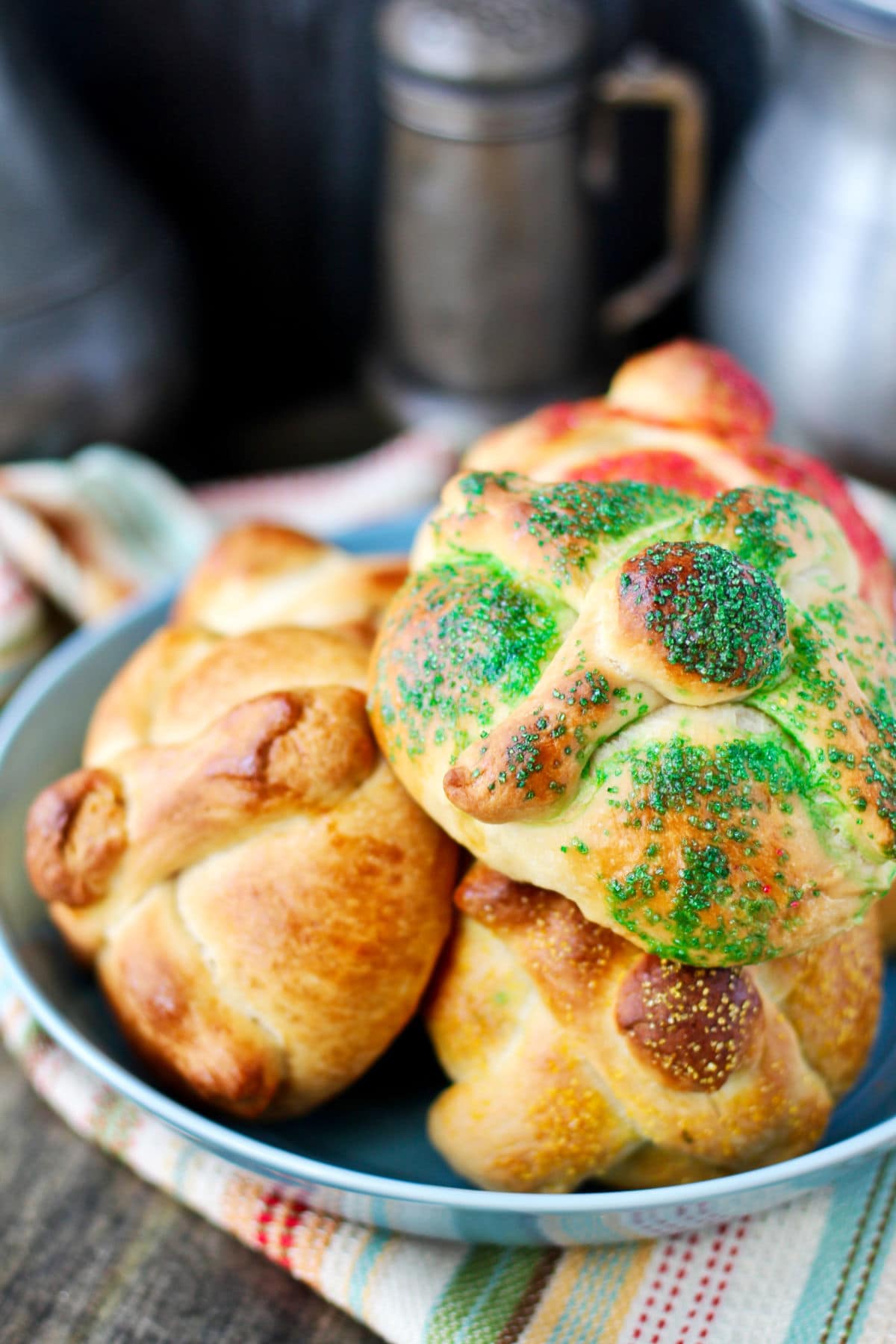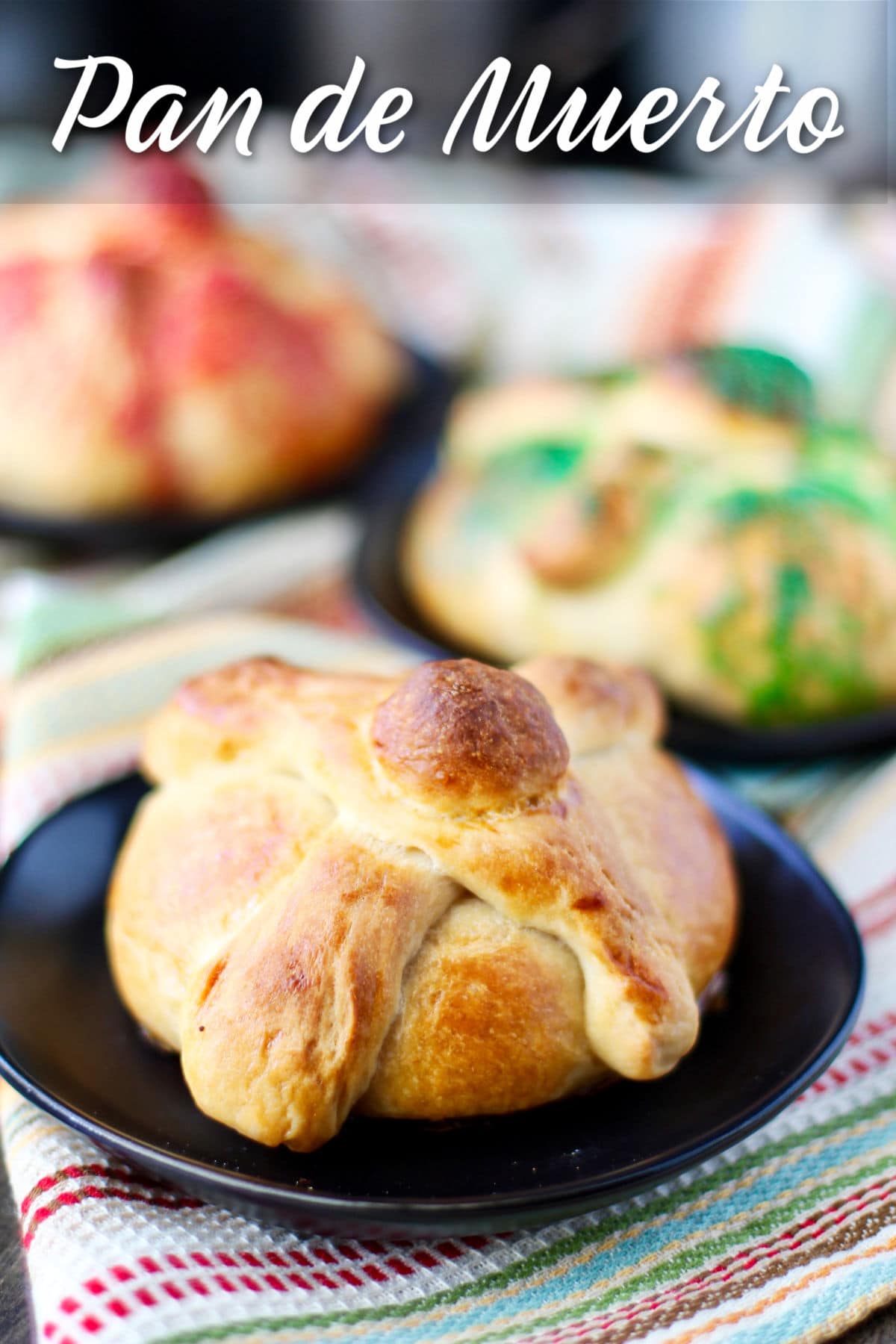This pan de muerto, or "Bread of the Dead," is a traditional Mexican bread served to honor loved ones who have passed away.
This pan de muerto is made with a very buttery brioche-like dough, but sweeter. The resulting bread is super rich, yet very airy and light.
There are many versions and shaping techniques for this bread as there are regions of Mexico, but this shaping method is probably the most common.
Pan de Muerto:
There is symbolism in the shaping of pan de muerto. The round shape of the loaf symbolizes the circle of life (and death). The ball on top is supposed to symbolize the skull of the deceased, and the crossed pieces of dough represent bones and tears.
This bread is placed on the Day of the Dead (Dia de Los Muertos) alter along with many other traditional dishes as an "ofrenda" (offering) to loved ones who have passed. It is traditionally served from Octover 31 to November 2.
Shaping Pan de Muerto Dough:
This is my first time making pan de muerto, so I probably need to work on my shaping skills. Some of the "skulls" moved off of the tops of the breads.
I watched the rolls as they were baking for the first few minutes and moved the balls back, but after walking away, two of the skulls moved as the bread rose in the oven. They kind of look like they are really exhausted don't they?
I shaped this dough into six rolls, but you can also shape it into two loaves. Just increase the baking time and check the internal temperature of the loaves before removing from the oven. They should reach about 200 degrees F and sound hollow when rapped on the underside with your knuckle.
This dough requires a long slow rise, so be sure to take that into account. Fortunately, the dough is very flexible too.
I mixed the dough around 8pm in the evening and then shape the rolls around 10am the next day. The dough requires an eight hour first rise, but if you go longer (as I did, I left the dough to rise for 14 hours) it is very forgiving as long as your rising spot is not too warm.
The overnight temperature in my kitchen was about 65 degrees F. If you are in a hot climate, you might want to use a picnic cooler with some ice in a bowl set to the side for the overnight rise.
This is just about the most buttery dough I've ever worked with. It's rich with butter, milk, and honey, and takes a long time to ferment. Believe me, it's worth it. I was a little worried at first, but the dough came together beautifully.
Even though the bread is sweet, it actually makes wonderful dough for sandwich rolls and even burger buns. There's something nice about the sweet and savory contrast.
It really helps to have a stand mixer to make this dough to bring it together, especially for incorporating so much butter. My favorite is the KitchenAid 7 Quart Pro (affliate link). It's pricey, but a workhorse. Plus, it's super gorgeous in red.
And can we talk kitchen scales? If you want this recipe to turn out perfectly (and wash less measuring cups), get one. My favorite is the OXO.
Pan de Muerto recipe variations:
You could add orange zest or orange flavoring to the dough, which is often found in pan de Muerto. Vanilla is also a common addition and would be delicious.
You could spice up the dough with an addition of cinnamon too, although you might have to add more yeast since cinnamon impairs yeast activity.
I left some of these rolls plain after brushing them with an egg wash, and sprinkled some with colored sugars before baking. Another sugary option is to brush the rolls after baking with melted butter and dipping them in granulated sugar while still warm.
Instead of sugar, sprinkle the egg washed dough with sesame seeds before baking.
What to do with leftovers:
You can store leftovers in an airtight container for up to three days. You can also individually wrap them and freeze them in a freezer bag for up to three months. Leftover rolls can be reheated in a 350 degree oven for a few minutes.
More Mexican Yeasted Bread:
Birotes Salados (Mexican Sourdough Rolls)
This week, the Sunday Funday group is posting recipes for Dia de los Muertos. Be sure to check out everyone's links:
- Atola- East Indian by Sneha's Recipe
- Caldo Tlalpeño by Food Lust People Love
- Dia de Los Muertos Sugar Skull Cake by Amy’s Cooking Adventures
- Enfrijoladas de Pollo by A Day in the Life on the Farm
- Fiambre Rojo for Día de los Muertos by Culinary Adventures with Camilla
- Pan de Muerto (Mexican Day of the Dead Bread) by Karen's Kitchen Stories
- Pan Seared Tilapia with Shrimp by Palatable Pastime
- Taco Casserole by Making Miracles
- Vegetarian Tortilla Soup by Mayuri's Jikoni
Pan de Muerto (Mexican Day of the Dead Bread)

Ingredients
- 1/2 teaspoon instant yeast
- 180 grams (3/4 cup) whole milk
- 415 grams (3 1/4 cups) bread flour
- 3/4 teaspoon Diamond Crystal Kosher salt
- 3/4 teaspoon baking powder
- 125 grams (9 tablespoons) unsalted butter, melted and cooled
- 105 grams (1/4 cup plus one tablespoon) honey
- One large egg
- One tablespoon water
- Pinch of salt
- Sparkling sugar for topping (optional)
Instructions
- In the bowl of a stand mixer, add all of the dough ingredients.
- Mix on low speed with the dough hook for about a minute, until everything is incorporated.
- Switch the speed to medium-high and continue for an additional 5 minutes, until you have a smooth dough.
- Place the dough into an oiled bowl, cover, and let rise until doubled, at least 8 hours. You can let the dough rise up to about 15 hours at room temperature.
- Line a rimmed baking sheet with parchment paper.
- Deflate the dough and, using a scale, portion off six 100 gram pieces of dough and form them into rounds. Place the rounds on the parchment lined baking sheet and cover loosely with oiled plastic wrap.
- Portion the rest of the dough into six equal pieces. Cut off some of each piece for the round "head" for topping the pan de muerto, and divide the rest of each piece into two.
- Roll each half into ropes, while leaving the ends larger than the middle to resemble the joints of bones.
- Cross the ropes over the rounds, pinching the ends and the middle. Top with the round "head." (See photo in post).
- Keep covered with oiled plastic wrap and let rise until puffy, about 2 1/2 to 3 hours.
- Heat the oven to 350 degrees F.
- Brush the rolls with the egg wash. Sprinkle with the optional sugar.
- Bake for 25 minutes, until golden brown. Cool slightly on a wire rack.
- Leftovers can be reheated in a 350 degree oven for a few minutes.
Nutrition Facts
Calories
343.78Fat (grams)
20.71Sat. Fat (grams)
11.80Carbs (grams)
52.04Fiber (grams)
1.75Net carbs
50.29Sugar (grams)
1.81Protein (grams)
11.74Sodium (milligrams)
281.97Cholesterol (grams)
112.89This recipe was adapted from an amazing bread book, Hot Bread Kitchen. The dough is originally for an Iranian bread called Nan-e Qandi. This book is so beautiful, a wonderful read, and the story of Hot Bread Kitchen is amazing.









I have ALWAYS wanted to make this recipe. Thanks for the inspiration. I might do it today!
ReplyDeleteThanks! How fun!
DeleteI wonder if this is where the skull and crossbones originated? The bread sounds lovely.
ReplyDeleteThanks! Interesting question!
DeleteI wouldn't be concerned if the knobs migrated. I'm pretty sure your bread dough is fantastic and flavor is the point.
ReplyDeleteThanks so much Sue!
DeleteCan't wait to try this bread Karen, perfectly baked!
ReplyDelete